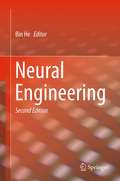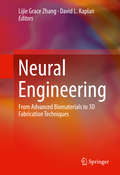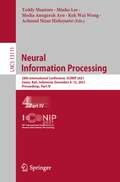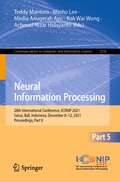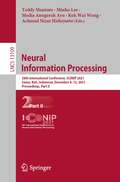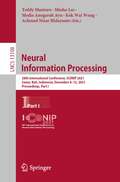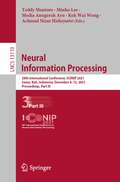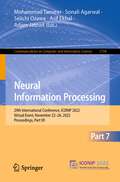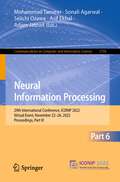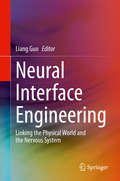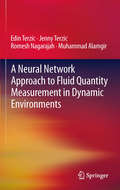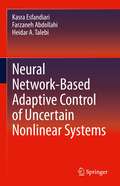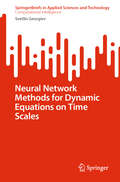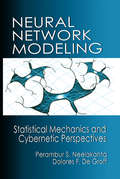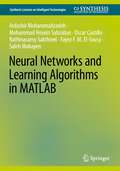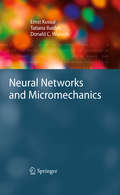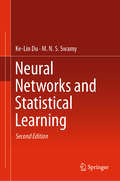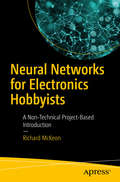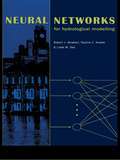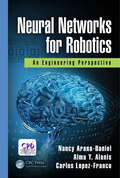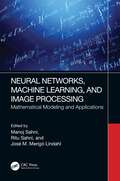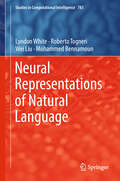- Table View
- List View
Neural Engineering
by Bin HeNeural Engineering, 2nd Edition, contains reviews and discussions of contemporary and relevant topics by leading investigators in the field. It is intended to serve as a textbook at the graduate and advanced undergraduate level in a bioengineering curriculum. This principles and applications approach to neural engineering is essential reading for all academics, biomedical engineers, neuroscientists, neurophysiologists, and industry professionals wishing to take advantage of the latest and greatest in this emerging field.
Neural Engineering
by Lijie Grace Grace Zhang David L. L. KaplanThis book covers the principles of advanced 3D fabrication techniques, stem cells and biomaterials for neural engineering. Renowned contributors cover topics such as neural tissue regeneration, peripheral and central nervous system repair, brain-machine interfaces and in vitro nervous system modeling. Within these areas, focus remains on exciting and emerging technologies such as highly developed neuroprostheses and the communication channels between the brain and prostheses, enabling technologies that are beneficial for development of therapeutic interventions, advanced fabrication techniques such as 3D bioprinting, photolithography, microfluidics, and subtractive fabrication, and the engineering of implantable neural grafts. There is a strong focus on stem cells and 3D bioprinting technologies throughout the book, including working with embryonic, fetal, neonatal, and adult stem cells and a variety of sophisticated 3D bioprinting methods for neural engineering applications. There is also a strong focus on biomaterials, including various conductive biomaterials and biomimetic nanomaterials such as carbon-based nanomaterials and engineered 3D nanofibrous scaffolds for neural tissue regeneration. Finally, two chapters on in vitro nervous system models are also included, which cover this topic in the context of studying physiology and pathology of the human nervous system, and for use in drug discovery research. This is an essential book for biomedical engineers, neuroscientists, neurophysiologists, and industry professionals.
Neural Information Processing: 28th International Conference, ICONIP 2021, Sanur, Bali, Indonesia, December 8–12, 2021, Proceedings, Part IV (Lecture Notes in Computer Science #13111)
by Teddy Mantoro Minho Lee Media Anugerah Ayu Kok Wai Wong Achmad Nizar HidayantoThe four-volume proceedings LNCS 13108, 13109, 13110, and 13111 constitutes the proceedings of the 28th International Conference on Neural Information Processing, ICONIP 2021, which was held during December 8-12, 2021. The conference was planned to take place in Bali, Indonesia but changed to an online format due to the COVID-19 pandemic. The total of 226 full papers presented in these proceedings was carefully reviewed and selected from 1093 submissions. The papers were organized in topical sections as follows: Part I: Theory and algorithms; Part II: Theory and algorithms; human centred computing; AI and cybersecurity; Part III: Cognitive neurosciences; reliable, robust, and secure machine learning algorithms; theory and applications of natural computing paradigms; advances in deep and shallow machine learning algorithms for biomedical data and imaging; applications; Part IV: Applications.
Neural Information Processing: 28th International Conference, ICONIP 2021, Sanur, Bali, Indonesia, December 8–12, 2021, Proceedings, Part V (Communications in Computer and Information Science #1516)
by Teddy Mantoro Minho Lee Media Anugerah Ayu Kok Wai Wong Achmad Nizar HidayantoThe two-volume set CCIS 1516 and 1517 constitutes thoroughly refereed short papers presented at the 28th International Conference on Neural Information Processing, ICONIP 2021, held in Sanur, Bali, Indonesia, in December 2021.* The volume also presents papers from the workshop on Artificial Intelligence and Cyber Security, held during the ICONIP 2021. The 176 short and workshop papers presented in this volume were carefully reviewed and selected for publication out of 1093 submissions. The papers are organized in topical sections as follows: theory and algorithms; AI and cybersecurity; cognitive neurosciences; human centred computing; advances in deep and shallow machine learning algorithms for biomedical data and imaging; reliable, robust, and secure machine learning algorithms; theory and applications of natural computing paradigms; applications.* The conference was held virtually due to the COVID-19 pandemic.
Neural Information Processing: 28th International Conference, ICONIP 2021, Sanur, Bali, Indonesia, December 8–12, 2021, Proceedings, Part II (Lecture Notes in Computer Science #13109)
by Teddy Mantoro Minho Lee Media Anugerah Ayu Kok Wai Wong Achmad Nizar HidayantoThe four-volume proceedings LNCS 13108, 13109, 13110, and 13111 constitutes the proceedings of the 28th International Conference on Neural Information Processing, ICONIP 2021, which was held during December 8-12, 2021. The conference was planned to take place in Bali, Indonesia but changed to an online format due to the COVID-19 pandemic. The total of 226 full papers presented in these proceedings was carefully reviewed and selected from 1093 submissions. The papers were organized in topical sections as follows: Part I: Theory and algorithms; Part II: Theory and algorithms; human centred computing; AI and cybersecurity; Part III: Cognitive neurosciences; reliable, robust, and secure machine learning algorithms; theory and applications of natural computing paradigms; advances in deep and shallow machine learning algorithms for biomedical data and imaging; applications; Part IV: Applications.
Neural Information Processing: 28th International Conference, ICONIP 2021, Sanur, Bali, Indonesia, December 8–12, 2021, Proceedings, Part I (Lecture Notes in Computer Science #13108)
by Teddy Mantoro Minho Lee Media Anugerah Ayu Kok Wai Wong Achmad Nizar HidayantoThe four-volume proceedings LNCS 13108, 13109, 13110, and 13111 constitutes the proceedings of the 28th International Conference on Neural Information Processing, ICONIP 2021, which was held during December 8-12, 2021. The conference was planned to take place in Bali, Indonesia but changed to an online format due to the COVID-19 pandemic. The total of 226 full papers presented in these proceedings was carefully reviewed and selected from 1093 submissions. The papers were organized in topical sections as follows: Part I: Theory and algorithms; Part II: Theory and algorithms; human centred computing; AI and cybersecurity; Part III: Cognitive neurosciences; reliable, robust, and secure machine learning algorithms; theory and applications of natural computing paradigms; advances in deep and shallow machine learning algorithms for biomedical data and imaging; applications; Part IV: Applications.
Neural Information Processing: 28th International Conference, ICONIP 2021, Sanur, Bali, Indonesia, December 8–12, 2021, Proceedings, Part III (Lecture Notes in Computer Science #13110)
by Teddy Mantoro Minho Lee Media Anugerah Ayu Kok Wai Wong Achmad Nizar HidayantoThe four-volume proceedings LNCS 13108, 13109, 13110, and 13111 constitutes the proceedings of the 28th International Conference on Neural Information Processing, ICONIP 2021, which was held during December 8-12, 2021. The conference was planned to take place in Bali, Indonesia but changed to an online format due to the COVID-19 pandemic. The total of 226 full papers presented in these proceedings was carefully reviewed and selected from 1093 submissions. The papers were organized in topical sections as follows: Part I: Theory and algorithms; Part II: Theory and algorithms; human centred computing; AI and cybersecurity; Part III: Cognitive neurosciences; reliable, robust, and secure machine learning algorithms; theory and applications of natural computing paradigms; advances in deep and shallow machine learning algorithms for biomedical data and imaging; applications; Part IV: Applications.
Neural Information Processing: 29th International Conference, ICONIP 2022, Virtual Event, November 22–26, 2022, Proceedings, Part VII (Communications in Computer and Information Science #1794)
by Mohammad Tanveer Sonali Agarwal Seiichi Ozawa Asif Ekbal Adam JatowtThe four-volume set CCIS 1791, 1792, 1793 and 1794 constitutes the refereed proceedings of the 29th International Conference on Neural Information Processing, ICONIP 2022, held as a virtual event, November 22–26, 2022. The 213 papers presented in the proceedings set were carefully reviewed and selected from 810 submissions. They were organized in topical sections as follows: Theory and Algorithms; Cognitive Neurosciences; Human Centered Computing; and Applications.The ICONIP conference aims to provide a leading international forum for researchers, scientists, and industry professionals who are working in neuroscience, neural networks, deep learning, and related fields to share their new ideas, progress, and achievements.
Neural Information Processing: 29th International Conference, ICONIP 2022, Virtual Event, November 22–26, 2022, Proceedings, Part VI (Communications in Computer and Information Science #1793)
by Mohammad Tanveer Sonali Agarwal Seiichi Ozawa Asif Ekbal Adam JatowtThe four-volume set CCIS 1791, 1792, 1793 and 1794 constitutes the refereed proceedings of the 29th International Conference on Neural Information Processing, ICONIP 2022, held as a virtual event, November 22–26, 2022. The 213 papers presented in the proceedings set were carefully reviewed and selected from 810 submissions. They were organized in topical sections as follows: Theory and Algorithms; Cognitive Neurosciences; Human Centered Computing; and Applications.The ICONIP conference aims to provide a leading international forum for researchers, scientists, and industry professionals who are working in neuroscience, neural networks, deep learning, and related fields to share their new ideas, progress, and achievements.
Neural Interface Engineering: Linking the Physical World and the Nervous System
by Liang GuoThis book provides a comprehensive reference to major neural interfacing technologies used to transmit signals between the physical world and the nervous system for repairing, restoring and even augmenting body functions. The authors discuss the classic approaches for neural interfacing, the major challenges encountered, and recent, emerging techniques to mitigate these challenges for better chronic performances. Readers will benefit from this book’s unprecedented scope and depth of coverage on the technology of neural interfaces, the most critical component in any type of neural prostheses.Provides comprehensive coverage of major neural interfacing technologies;Reviews and discusses both classic and latest, emerging topics;Includes classification of technologies to provide an easy grasp of research and trends in the field.
Neural Interface: Frontiers and Applications (Advances in Experimental Medicine and Biology #1101)
by Xiaoxiang ZhengThis book focuses on the frontiers of neural interface technology, including hardware, software, neural decoding and encoding, control systems, and system integration. It also discusses applications for neuroprosthetics, neural diseases and neurorobotics, and the toolkits for basic neuroscience. A neural interface establishes a direct communication channel with the central or peripheral nervous system (CNS or PNS), and enables the nervous system to interact directly with the external devices. Recent advances in neuroscience and engineering are speeding up neural interface technology, paving the way for assisting, augmenting, repairing or restoring sensorimotor and other cognitive functions impaired due to neurological disease or trauma, and so improving the quality of life of those affected. Neural interfaces are now being explored in applications as diverse as rehabilitation, accessibility, gaming, education, recreation, robotics and human enhancement. Neural interfaces also represent a powerful tool to address fundamental questions in neuroscience. Recent decades have witnessed tremendous advances in the field, with a huge impact not only in the development of neuroprosthetics, but also in our basic understanding of brain function. Neural interface technology can be seen as a bridge across the traditional engineering and basic neuroscience. This book provides researchers, graduate and upper undergraduate students from a wide range of disciplines with a cutting-edge and comprehensive summary of neural interface engineering research.
A Neural Network Approach to Fluid Quantity Measurement in Dynamic Environments
by Edin Terzic Romesh Nagarajah Muhammad Alamgir Jenny TerzicSloshing causes liquid to fluctuate, making accurate level readings difficult to obtain in dynamic environments. The measurement system described uses a single-tube capacitive sensor to obtain an instantaneous level reading of the fluid surface, thereby accurately determining the fluid quantity in the presence of slosh. A neural network based classification technique has been applied to predict the actual quantity of the fluid contained in a tank under sloshing conditions. In A neural network approach to fluid quantity measurement in dynamic environments, effects of temperature variations and contamination on the capacitive sensor are discussed, and the authors propose that these effects can also be eliminated with the proposed neural network based classification system. To examine the performance of the classification system, many field trials were carried out on a running vehicle at various tank volume levels that range from 5 L to 50 L. The effectiveness of signal enhancement on the neural network based signal classification system is also investigated. Results obtained from the investigation are compared with traditionally used statistical averaging methods, and proves that the neural network based measurement system can produce highly accurate fluid quantity measurements in a dynamic environment. Although in this case a capacitive sensor was used to demonstrate measurement system this methodology is valid for all types of electronic sensors. The approach demonstrated in A neural network approach to fluid quantity measurement in dynamic environments can be applied to a wide range of fluid quantity measurement applications in the automotive, naval and aviation industries to produce accurate fluid level readings. Students, lecturers, and experts will find the description of current research about accurate fluid level measurement in dynamic environments using neural network approach useful.
Neural Network-Based Adaptive Control of Uncertain Nonlinear Systems
by Kasra Esfandiari Farzaneh Abdollahi Heidar A. TalebiThe focus of this book is the application of artificial neural networks in uncertain dynamical systems. It explains how to use neural networks in concert with adaptive techniques for system identification, state estimation, and control problems. The authors begin with a brief historical overview of adaptive control, followed by a review of mathematical preliminaries. In the subsequent chapters, they present several neural network-based control schemes. Each chapter starts with a concise introduction to the problem under study, and a neural network-based control strategy is designed for the simplest case scenario. After these designs are discussed, different practical limitations (i.e., saturation constraints and unavailability of all system states) are gradually added, and other control schemes are developed based on the primary scenario. Through these exercises, the authors present structures that not only provide mathematical tools for navigating control problems, but also supply solutions that are pertinent to real-life systems.
Neural Network Control of Nonlinear Discrete-Time Systems (Automation and Control Engineering)
by Jagannathan SarangapaniIntelligent systems are a hallmark of modern feedback control systems. But as these systems mature, we have come to expect higher levels of performance in speed and accuracy in the face of severe nonlinearities, disturbances, unforeseen dynamics, and unstructured uncertainties. Artificial neural networks offer a combination of adaptability, parallel processing, and learning capabilities that outperform other intelligent control methods in more complex systems.Borrowing from BiologyExamining neurocontroller design in discrete-time for the first time, Neural Network Control of Nonlinear Discrete-Time Systems presents powerful modern control techniques based on the parallelism and adaptive capabilities of biological nervous systems. At every step, the author derives rigorous stability proofs and presents simulation examples to demonstrate the concepts.Progressive DevelopmentAfter an introduction to neural networks, dynamical systems, control of nonlinear systems, and feedback linearization, the book builds systematically from actuator nonlinearities and strict feedback in nonlinear systems to nonstrict feedback, system identification, model reference adaptive control, and novel optimal control using the Hamilton-Jacobi-Bellman formulation. The author concludes by developing a framework for implementing intelligent control in actual industrial systems using embedded hardware.Neural Network Control of Nonlinear Discrete-Time Systems fosters an understanding of neural network controllers and explains how to build them using detailed derivations, stability analysis, and computer simulations.
Neural Network Control Of Robot Manipulators And Non-Linear Systems
by F W Lewis S. Jagannathan A YesildirakThere has been great interest in "universal controllers" that mimic the functions of human processes to learn about the systems they are controlling on-line so that performance improves automatically. Neural network controllers are derived for robot manipulators in a variety of applications including position control, force control, link flexibility stabilization and the management of high-frequency joint and motor dynamics.The first chapter provides a background on neural networks and the second on dynamical systems and control. Chapter three introduces the robot control problem and standard techniques such as torque, adaptive and robust control. Subsequent chapters give design techniques and Stability Proofs For NN Controllers For Robot Arms, Practical Robotic systems with high frequency vibratory modes, force control and a general class of non-linear systems. The last chapters are devoted to discrete- time NN controllers. Throughout the text, worked examples are provided.
Neural Network Methods for Dynamic Equations on Time Scales (SpringerBriefs in Applied Sciences and Technology)
by Svetlin GeorgievThis book aims to handle dynamic equations on time scales using artificial neural network (ANN). Basic facts and methods for ANN modeling are considered. The multilayer artificial neural network (ANN) model is introduced for solving of dynamic equations on arbitrary time scales. A multilayer ANN model with one input layer containing a single node, a hidden layer with m nodes, and one output node are investigated. The feed-forward neural network model and unsupervised error back-propagation algorithm are developed. Modification of network parameters is done without the use of any optimization technique. The regression-based neural network (RBNN) model is introduced for solving dynamic equations on arbitrary time scales. The RBNN trial solution of dynamic equations is obtained by using the RBNN model for single input and single output system. A variety of initial and boundary value problems are solved. The Chebyshev neural network (ChNN) model and Levendre neural network model are developed. The ChNN trial solution of dynamic equations is obtained by using the ChNN model for single input and single output system. This book is addressed to a wide audience of specialists such as mathematicians, physicists, engineers, and biologists. It can be used as a textbook at the graduate level and as a reference book for several disciplines.
Neural Network Modeling: Statistical Mechanics and Cybernetic Perspectives
by P. S. Neelakanta Dolores DeGroffNeural Network Modeling offers a cohesive approach to the statistical mechanics and principles of cybernetics as a basis for neural network modeling. It brings together neurobiologists and the engineers who design intelligent automata to understand the physics of collective behavior pertinent to neural elements and the self-control aspects of neurocybernetics. The theoretical perspectives and explanatory projections portray the most current information in the field, some of which counters certain conventional concepts in the visualization of neuronal interactions.
Neural Networks and Learning Algorithms in MATLAB (Synthesis Lectures on Intelligent Technologies)
by Oscar Castillo Rathinasamy Sakthivel Mohammad Hosein Sabzalian Fayez F. El-Sousy Ardahir Mohammadazadeh Saleh MobayenThis book explains the basic concepts, theory and applications of neural networks in a simple unified approach with clear examples and simulations in the MATLAB programming language. The scripts herein are coded for general purposes to be easily extended to a variety of problems in different areas of application. They are vectorized and optimized to run faster and be applicable to high-dimensional engineering problems. This book will serve as a main reference for graduate and undergraduate courses in neural networks and applications. This book will also serve as a main basis for researchers dealing with complex problems that require neural networks for finding good solutions in areas, such as time series prediction, intelligent control and identification. In addition, the problem of designing neural network by using metaheuristics, such as the genetic algorithms and particle swarm optimization, with one objective and with multiple objectives, is presented.
Neural Networks and Micromechanics
by Tatiana Baidyk Ernst Kussul Donald C. WunschThis is an interdisciplinary field of research involving the use of neural network techniques for image recognition applied to tasks in the area of micromechanics. The book is organized into chapters on classic neural networks and novel neural classifiers; recognition of textures and object forms; micromechanics; and adaptive algorithms with neural and image recognition applications. The authors include theoretical analysis of the proposed approach, they describe their machine tool prototypes in detail, and they present results from experiments involving microassembly, and handwriting and face recognition. This book will benefit scientists, researchers and students working in artificial intelligence, particularly in the fields of image recognition and neural networks, and practitioners in the area of microengineering.
Neural Networks and Statistical Learning
by Ke-Lin Du M. N. SwamyThis book provides a broad yet detailed introduction to neural networks and machine learning in a statistical framework. A single, comprehensive resource for study and further research, it explores the major popular neural network models and statistical learning approaches with examples and exercises and allows readers to gain a practical working understanding of the content. This updated new edition presents recently published results and includes six new chapters that correspond to the recent advances in computational learning theory, sparse coding, deep learning, big data and cloud computing.Each chapter features state-of-the-art descriptions and significant research findings. The topics covered include:• multilayer perceptron;• the Hopfield network;• associative memory models;• clustering models and algorithms;• t he radial basis function network;• recurrent neural networks;• nonnegative matrix factorization;• independent component analysis;•probabilistic and Bayesian networks; and• fuzzy sets and logic.Focusing on the prominent accomplishments and their practical aspects, this book provides academic and technical staff, as well as graduate students and researchers with a solid foundation and comprehensive reference on the fields of neural networks, pattern recognition, signal processing, and machine learning.
Neural Networks for Electronics Hobbyists: A Non-technical Project-based Introduction
by Richard McKeonLearn how to implement and build a neural network with this non-technical, project-based book as your guide. As you work through the chapters, you'll build an electronics project, providing a hands-on experience in training a network. There are no prerequisites here and you won't see a single line of computer code in this book. Instead, it takes a hardware approach using very simple electronic components. You'll start off with an interesting non-technical introduction to neural networks, and then construct an electronics project. The project isn't complicated, but it illustrates how back propagation can be used to adjust connection strengths or "weights" and train a network. By the end of this book, you'll be able to take what you've learned and apply it to your own projects. If you like to tinker around with components and build circuits on a breadboard, Neural Networks for Electronics Hobbyists is the book for you. What You'll LearnGain a practical introduction to neural networksReview techniques for training networks with electrical hardware and supervised learningUnderstand how parallel processing differs from standard sequential programmingWho This Book Is ForAnyone interest in neural networks, from electronic hobbyists looking for an interesting project to build, to a layperson with no experience. Programmers familiar with neural networks but have only implemented them using computer code will also benefit from this book.
Neural Networks for Hydrological Modeling
by Robert J. Abrahart Pauline E. Kneale Linda M. SeeA new approach to the fast-developing world of neural hydrological modelling, this book is essential reading for academics and researchers in the fields of water sciences, civil engineering, hydrology and physical geography. Each chapter has been written by one or more eminent experts working in various fields of hydrological modelling. The b
Neural Networks for Robotics: An Engineering Perspective
by Nancy Arana-Daniel Alma Y. Alanis Carlos Lopez-FrancoThe book offers an insight on artificial neural networks for giving a robot a high level of autonomous tasks, such as navigation, cost mapping, object recognition, intelligent control of ground and aerial robots, and clustering, with real-time implementations. The reader will learn various methodologies that can be used to solve each stage on autonomous navigation for robots, from object recognition, clustering of obstacles, cost mapping of environments, path planning, and vision to low level control. These methodologies include real-life scenarios to implement a wide range of artificial neural network architectures. Includes real-time examples for various robotic platforms. Discusses real-time implementation for land and aerial robots. Presents solutions for problems encountered in autonomous navigation. Explores the mathematical preliminaries needed to understand the proposed methodologies. Integrates computing, communications, control, sensing, planning, and other techniques by means of artificial neural networks for robotics.
Neural Networks, Machine Learning, and Image Processing: Mathematical Modeling and Applications
by Manoj Sahni Ritu Sahni Jose M. MerigoSECTION I Mathematical Modeling and Neural Network’ Mathematical Essence Chapter 1 Mathematical Modeling on Thermoregulation in Sarcopenia1.1. Introduction 1.2. Discretization 1.3. Modeling and Simulation of Basal Metabolic Rate and Skin Layers Thickness 1.4. Mathematical Model and Boundary Conditions 1.5. Solution of the Model 1.6. Numerical Results and discussion 1.7. Conclusion References Chapter 2 Multi-objective University Course Scheduling for Un
Neural Representations of Natural Language (Studies in Computational Intelligence #783)
by Lyndon White Roberto Togneri Wei Liu Mohammed BennamounThis book offers an introduction to modern natural language processing using machine learning, focusing on how neural networks create a machine interpretable representation of the meaning of natural language. Language is crucially linked to ideas – as Webster’s 1923 “English Composition and Literature” puts it: “A sentence is a group of words expressing a complete thought”. Thus the representation of sentences and the words that make them up is vital in advancing artificial intelligence and other “smart” systems currently being developed. Providing an overview of the research in the area, from Bengio et al.’s seminal work on a “Neural Probabilistic Language Model” in 2003, to the latest techniques, this book enables readers to gain an understanding of how the techniques are related and what is best for their purposes. As well as a introduction to neural networks in general and recurrent neural networks in particular, this book details the methods used for representing words, senses of words, and larger structures such as sentences or documents. The book highlights practical implementations and discusses many aspects that are often overlooked or misunderstood. The book includes thorough instruction on challenging areas such as hierarchical softmax and negative sampling, to ensure the reader fully and easily understands the details of how the algorithms function. Combining practical aspects with a more traditional review of the literature, it is directly applicable to a broad readership. It is an invaluable introduction for early graduate students working in natural language processing; a trustworthy guide for industry developers wishing to make use of recent innovations; and a sturdy bridge for researchers already familiar with linguistics or machine learning wishing to understand the other.
